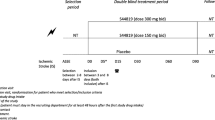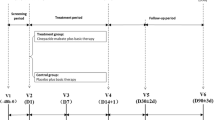Abstract
Background: Edaravone is a free-radical scavenger that has been widely used for acute ischaemic stroke in Japan. However, the optimal total dosage of edaravone has not been established.
Objective: To clarify the relationship between the gain in functional recovery (rehabilitation gain) and the total amount of edaravone used for acute-phase therapy for cerebral infarction at a convalescent rehabilitation hospital. We also sought to determine if there were differences in outcome between stroke subtypes.
Methods: Medical records were retrospectively surveyed to identify patients who had received edaravone treatment for acute-phase cerebral infarction at Kawakita General Hospital, Tokyo, Japan, followed by recovery rehabilitation at Kawakita Rehabilitation Hospital, Tokyo, Japan, for ≥30 days. Edaravone was initiated within 24 hours of stroke onset, and was administered as a 30 mg (1 ampoule) continuous intravenous infusion twice daily for up to 14 days. Patients were stratified into tertiles based on the total amount of edaravone used (measured in ampoules) during the acute phase (i.e. administration duration). Rehabilitation gain was defined as the change (increase) from convalescent rehabilitation hospital admission to discharge in the Functional Independence Measure-Motor (ΔFIM-M) or Barthel Index (ΔBI) score.
Results: Of the 72 enrolled patients, 21 belonged to the lower (short-term) tertile (0–14 ampoules), 27 to the middle (medium-term) tertile (15–23 ampoules) and 24 to the upper (long-term) tertile (24–33 ampoules) groups. There was no correlation between the total amount of edaravone used and the length of stay at an acute-phase hospital. However, a significant correlation was seen between the total amount of edaravone used and ΔFIM-M (adjusted regression coefficient 0.81; p = 0.003) and ΔBI (0.88; p = 0.005) score in patients with cardioembolic stroke; no significant correlation was seen in other stroke subtypes. Cardioembolic stroke patients also showed improvements in both FIM-M and BI score as the total amount of edaravone used increased. The difference between the short- and long-term group was 10.1 (95% CI 2.3, 17.8) for ΔFIM-M score, and 12.0 (95% CI 2.8, 21.2) for ΔBI score. Patients with atherothrombotic stroke showed a similar tendency with respect to ΔBI score.
Conclusion: Edaravone dose-dependently increases rehabilitation gain according to ΔFIM-M and ΔBI scores in patients with cardioembolic stroke, and a similar trend was also observed with respect to ΔBI score in patients with atherothrombotic stroke. This suggests that the total amount of edaravone used is associated with its efficacy for rehabilitation gain.




Similar content being viewed by others
References
Ministry of Health, Labour and Welfare. Trends in leading causes of death: summary of vital statistics. Tokyo: Statistics and Information Department Minister’s Secretariat Ministry of Health, Labour and Welfare, 2009 Oct 22
Cerebral Embolism Task Force. Cardiogenic brain embolism. Arch Neurol 1986; 43: 71–84
Wolf PA, Abbott RD, Kannel WB. Atrial fibrillation as an independent risk factor for stroke: the Framingham Study. Stroke 1991; 22: 983–8
Yamaguchi T. Intermediate results of the post-marketing survey of rt-PA [in Japanese]. Jpn J Stroke 2008; 30: 760–3
Tei H. Frequency and its annual change of usage of antithrombotic agent and edarabone according to stroke subtype. Stroke databank [in Japanese]. Tokyo: Nakayama Shoten Company,Limited, 2005: 80–1
Yamamoto Y, Kuwahara T, Wanatabe K, et al. Antioxidant activity of 3-methyl-1-phenyl-2-pyrazolin-5-one. Redox Rep 1996; 2: 333–8
Watanabe T, Morita I, Nishi H, et al. Preventive effect of MCI-186 on 15-HPETE induced vascular endothelial cell injury in vitro. Prostaglandins Leukot Essent Fatty Acids 1988; 33: 81–7
Abe K, Yuki S, Kogure K. Strong attenuation of ischemic and postischemic brain edema in rats by a novel free radical scavenger. Stroke 1988; 19: 480–5
Yamamoto T, Yuki S, Watanabe T, et al. Delayed neuronal death prevented by inhibition of increased hydroxyl radical formation in a transient cerebral ischemia. Brain Res 1997; 762: 240–2
The Edaravone Acute Brain Infarction Study Group. Effect of a novel free radical scavenger, edaravone (MCI-186), on acute brain infarction: randomized, placebo-controlled, double-blind study at multicenters. Cerebrovasc Dis 2003; 15: 222–9
Joint Committee on Guidelines for the Management of Stroke. Japanese guidelines for the management of stroke 2009 [in Japanese]. Tokyo: Kyowa Kikaku, 2009
Mitsubishi Tanabe Pharma Corporation. Radicut (edaravone) prescribing information [in Japanese]. Osaka: Mitsubishi Tanabe Pharma Corporation, 2009
Naritomi H. Research on the influences of muscle atrophy preventive therapy starting from the acute phase of cerebral infarction on chronic phase motor function [in Japanese]. Health Labour Science Research Grant, Comprehensive Research on Aging and Health. 2007 Overview Study Rep 2008. Osaka: Ministry of Health, Labour and Welfare of Japan, 2008
Kageyama M, Toriyama S, Tsuboshita A, et al. A postmarketing drug use survey of a neuroprotective drug Radicut injection 30 mg (nonproprietary name: edaravone) for acute ischemic stroke [in Japanese]. J New Rem Clin 2009; 58: 1212–26
Okamura S, Kobayashi R, Sakamaki T. Case-mix payment in Japanese medical care. Health Policy 2005; 74: 282–6
Yasunaga H, Ide H, Imamura T, et al. Influence of Japan’s new diagnosis procedure combination-based payment system on the surgical sector: does it really shorten the hospital stay? Surg Today 2006; 36: 577–85
Muranaga F, Kumamoto I, Uto Y, et al. Development of hospital data warehouse for cost analysis of DPC based on medical costs. Methods Inf Med 2007; 46: 679–85
Fushimi K, Hashimoto H, Imanaka Y, et al. Functional mapping of hospitals by diagnosis-dominant case-mix analysis. BMC Health Serv Res 2007; 7: 50
Adams HP, Bendixen BH, Kappelle LJ, et al. Classification of subtype of acute ischemic stroke definitions for use in a multicenter clinical trial. Stroke 1993; 24: 35–41
Keith RA, Granger CV, Hamilton BB, et al. The functional independence measure: a new tool for rehabilitation. Adv Clin Rehabil 1987; 1: 6–18
Mahoney FI, Barthel DW. Functional evaluation: the Barthel Index. Maryland State Med J 1965 Feb; 14: 61–5
Ueno Y, Zhang N, Miyamoto N, et al. Edaravone attenuates white matter lesions through endothelial protection in a rat chronic hypoperfusion model. Neuroscience 2009; 162: 317–27
Shinohara Y, Saito I, Kobayashi S, et al. Edaravone (radical scavenger) versus sodium ozagrel (antiplatelet Agent) in acute noncardioembolic ischemic stroke (EDO Trial). Cerebrovasc Dis 2009; 27: 485–92
Kikuchi K, Tancharoen S, Matsuda F, et al. Edaravone attenuates cerebral ischemic injury by suppressing aquaporin-4. Biochem Biophys Res Commun 2009; 390: 1121–5
Toyoda K, Fujii K, Kamouchi M, et al. Free radical scavenger, edaravone, in stroke with internal carotid artery occlusion. J Neurol Sci 2004 Jun 15; 221(1-2): 11–7
Yamaguchi S, Takahashi K, Kobayashi S. Thrombolytic therapy and cerebroprotecting drug (edaravone) coadministration therapy: stroke databank [in Japanese]. Tokyo: Nakayama Shoten Company, Limited, 2005: 98–9
Yamada K, Yoshikawa Y, Nishimura S, et al. Do anti-thrombotic drug and edaravone combined therapies serve to decrease the frequency of progressive lacuna infarction? Jpn J Stroke 2007; 28: 652–4
Mishina M, Komaba Y, Kobayashi S, et al. Efficacy of edaravone, a free radical scavenger, for the treatment of acute lacunar infarction. Neurol Med Chir (Tokyo) 2005; 45(7): 344–8
Matsumoto S, Horio S, Matayoshi S, et al. Therapy of acute cerebral infarction influencing convalescent rehabilitation: focusing on cerebroprotective drug, edaravone [abstract]. Jpn J Rehab Med 2005; 42(6): 429
Goto F. Official announcement of Japan Stroke Scale. Jpn J Stroke 1997; 19: 1–5
Lyden P, Brott T, Tilley B, et al. Improved reliability of the NIH Stroke Scale using video training. NINDS TPA Stroke Study Group. Stroke 1994; 25: 2220–6
van Swieten JC, Koudstaal PJ, Visser MC, et al. Interobserver agreement for the assessment of handicap in stroke patients. Stroke 1988; 19: 604–7
Wang PY, Kao CH, Mui MY, et al. Leukocyte infiltration in acute hemispheric ischemic stroke. Stroke 1993; 24: 236–40
Kawase T, Mizukami M, Tazawa T, et al. Dynamic pathophysiology of cerebral infarction and revascularization. I: ischemic cerebral edema [in Japanese]. No To Shinkei 1982; 34: 1077–83
Lodder J, Krijne-Kubat B, van der Lugt PJ. Timing of autopsy-confirmed hemorrhagic infarction with reference to cardio-embolic stroke. Stroke 1988; 19: 1482–4
Suzuki K. Pathology of cardioembolic stroke [in Japanese]. Ther Res 2000; 3: 403–8
Houkin K, Ueno K, Tada M, et al. Arterial recanalization in acute stage of cerebral infarction [in Japanese]. Neurol Med Chir (Tokyo) 1987; 27: 295–301
Peters O, Back T, Lindauer U, et al. Increased formation of reactive oxygen species after permanent and reversible middle cerebral artery occlusion in the rat. J Cereb Blood Flow Metab 1998; 18: 196–205
Furuya D, Tanahashi N, Araki N, et al. Edaravone therapy initiated immediately after cardioembolic stroke and its effects on functional recovery. Jpn J Stroke 2006; 28: 291–6
Yamamoto Y, Ohara T, Hamanaka M, et al. Predictive factors for progressive motor deficits in penetrating artery infarctions in two different arterial territories. J Neurol Sci 2010 Jan 15; 288: 170–4
Clavier I, Hommel M, Besson G, et al. Long-term prognosis of symptomatic lacunar infarcts: a hospital-based study. Stroke 1994; 25: 2005–9
Samuelsson M, Söderfeldt B, Olsson GB. Functional outcome in patients with lacunar infarction. Stroke 1996; 27: 842–6
Hassaballa H, Gorelick PB, West CP, et al. Ischemic stroke outcome: racial differences in the trial of danaparoid in acute stroke (TOAST). Neurology 2001; 57: 691–7
Uno M, Kitazato K, Suzue A, et al. Inhibition of brain damage by edaravone, a free radical scavenger, can be monitored by plasma biomarkers that detect oxidative and astrocyte damage in patients with acute cerebral infarction. Free Radical Biol Med 2005; 39: 1109–16
Inouye M. Predicting models of outcome stratified by age after first stroke rehabilitation in Japan. Am J Phys Med Rehabil 2001; 8: 586–91
Musicco M, Emberti L, Nappi G, et al. Early and long-term outcome of rehabilitation in stroke patients: the role of patient characteristics, time of initiation, and duration of interventions. Arch Phys Med Rehabil 2003; 84: 551–8
Ng YS, Stein J, Salles SS, et al. Clinical characteristics and rehabilitation outcomes of patients with posteriar cerebral artery stroke. Arch Phys Med Rehabil 2005; 86: 2138–43
Ergreletzis D, Kevorkian CG, Rintala D. Rehabilitation of the older stroke patient: functional outcome and comparison with younger patients. Am J Phys Med Rehabil 2002; 81: 881–9
Acknowledgements
No sources of funding were used to assist in the conduct of this study. The authors have no conflicts of interest that are directly relevant to the content of this study. Medical writing assistance was provided by Maxwell Chang of inScience Communications. This assistance was funded by Mitsubishi Tanabe Pharma Corporation.
Author information
Authors and Affiliations
Corresponding author
Rights and permissions
About this article
Cite this article
Unno, Y., Katayama, M. & Shimizu, H. Does Functional Outcome in Acute Ischaemic Stroke Patients Correlate with the Amount of Free-Radical Scavenger Treatment?. Clin. Drug Investig. 30, 143–155 (2010). https://doi.org/10.2165/11535500-000000000-00000
Published:
Issue Date:
DOI: https://doi.org/10.2165/11535500-000000000-00000




